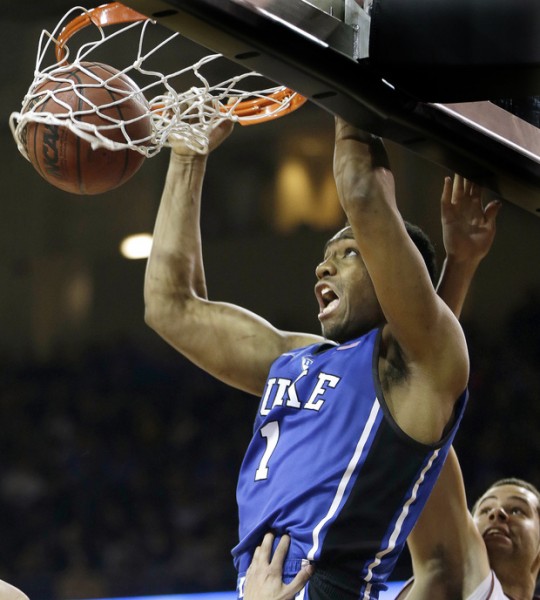Duke’s Quest For Tempo-Free History Rolls Through Chestnut Hill
Posted by Matt Patton on February 9th, 2014Since Ken Pomeroy first rolled out his ratings for the 2002-03 season, no team has finished with an offensive efficiency above 124.0 (a record set by Chris Paul and Wake Forest’s 2004-05 team). After trouncing Boston College on the road with its second most efficient game of the season, Duke’s adjusted offensive efficiency for this year is now an astounding 128.9 points per 100 possessions. The Blue Devils steamrolled a small Eagles team with an unbelievable performance from Jabari Parker, who finished with 38 points on 17 shots (leaving five points at the free throw line). They did it with an opening 32-9 run in the first 11 minutes of the second half. They did it dominating points off turnovers (15-3) and second chance points (22-7).

Jabari Parker was a force of nature against Boston College. (credit: Stephan Savoia / AP)
Admittedly, Boston College’s defense leaves a lot to be desired. Good defense doesn’t give up nearly 70 percent shooting over the course of a half at home. But Duke’s offensive polymathy is what makes them so dangerous. Duke normally has four three-point shooters on the floor at any given time. Once entirely ignored by Seth Greenberg, Tyler Thornton is shooting nearly 53 percent from three-point range (mostly wide open spot-ups). Five truly dangerous shooters (not counting Thornton despite his gaudy percentage) makes Duke a lot less susceptible to “dying by the three,” instead riding the night’s hot hands up the scoreboard.
It’s hard to overstate Duke’s versatility, but understand that everything starts with Parker. Triangle radio host Joe Ovies discussed the possibility that Parker doesn’t make first team all-ACC, but that’s only true if you look at his numbers. The amount of effort teams are forced to expend trying to contain him makes him Duke’s most valuable player even with lower percentages. Mike Krzyzewski needs Parker to be involved in every possession on the floor, and he always draws an opponent’s best defender and often a second one. This opens the floor up for Rodney Hood and Rasheed Sulaimon — great offensive players in their own right — to dominate games.
Steve Donahue pointed to two adjustments Duke made in the second half to go on the game-defining run: The Blue Devils started switching on all screens, which left the Eagles a tentative jump-shooting team; and “they just made sure that they got a post touch.” That first change shows some flexibility on defense (and probably doesn’t give enough credit to the extra pressure Duke put on the ball). The second could be the key to getting past its defense and to Arlington this April. Duke’s defense mostly struggles with keeping track of players without the ball. They still have a little trouble staying in front of quick players, like Olivier Hanlan, but much of Boston College’s offense came from late closeouts or poor coverage on cuts to the basket. That’s not new. At Conte Forum Quinn Cook and Hood were the primary offenders. Against North Carolina it might be Parker or Sulaimon. While the team played much more inspired defense in the second half, Boston College still finished with strong offensive numbers.
There will be a lot of questions raised about Duke’s championship chances this season because of its very pedestrian defense. But if Duke can run its offense inside-out against bigger opponents, it likely won’t matter. That’s why Duke’s upcoming trip to Chapel Hill and the Syracuse rematch should prove good postseason litmus tests.









































